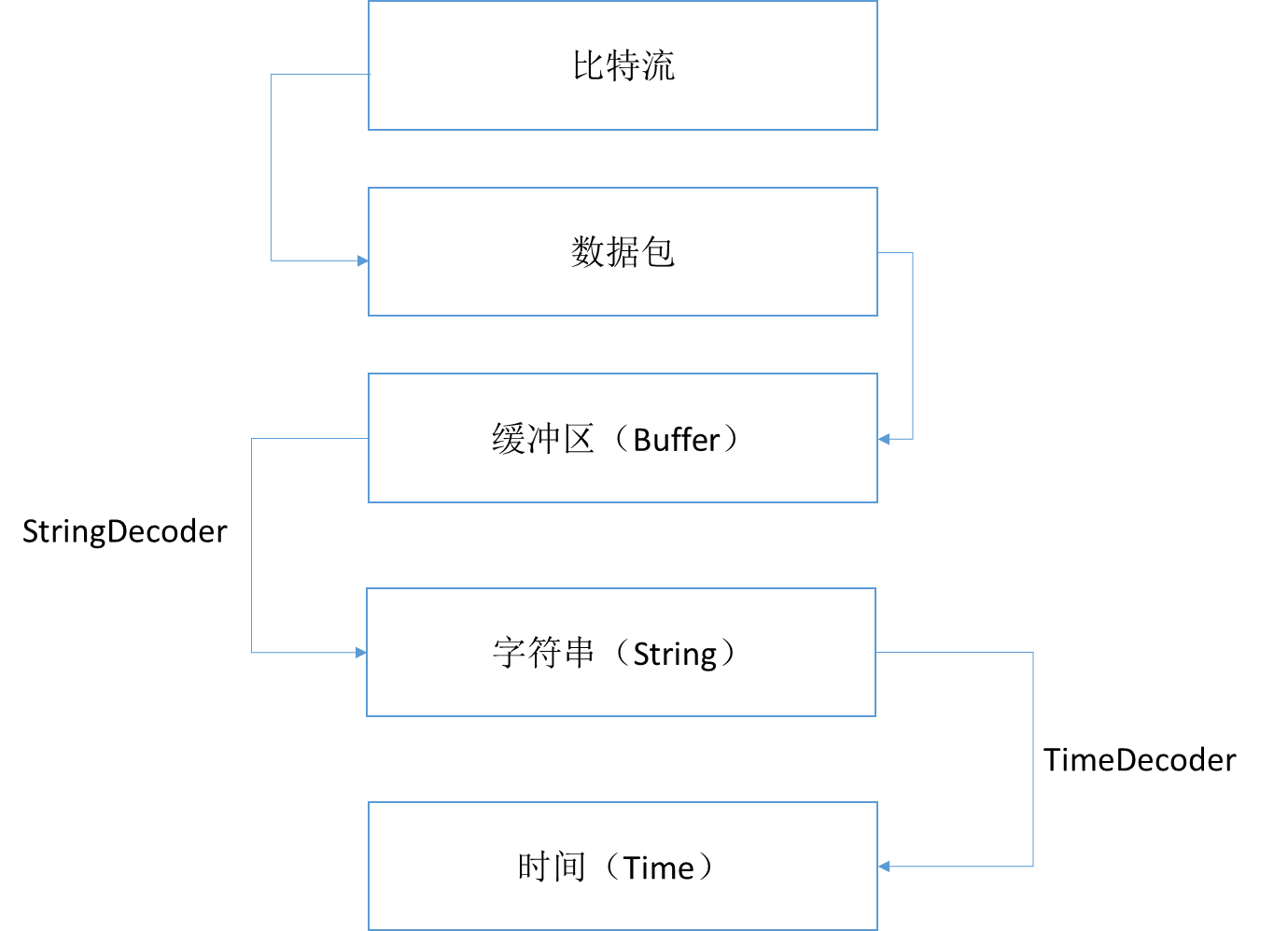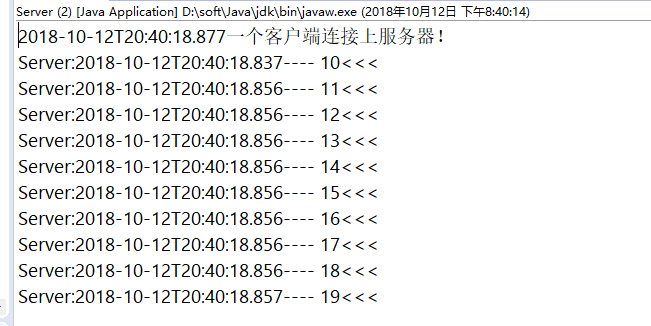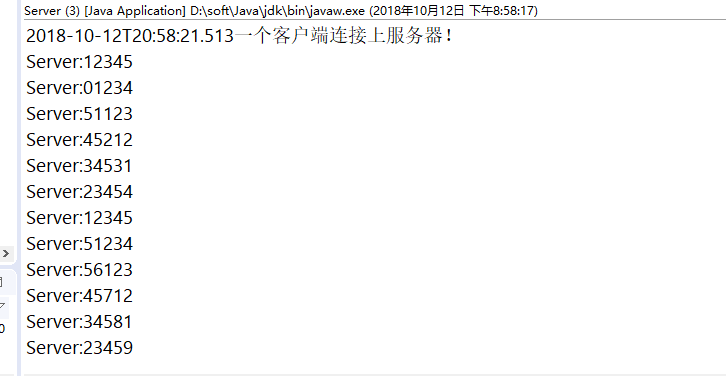3.Netty的粘包、拆包(二)
Netty提供的TCP数据拆包、粘包解决方案
1.前言
关于TCP的数据拆包、粘包的介绍,我在上一篇文章里面已经有过介绍。
想要了解一下的,请点击这里 Chick Here!
今天我们要讲解的是Netty提供的两种解决方案:
- DelimiterBasedFrameDecoder
- FixedLengthFrameDecoder
2.关于Decoder
先观察下两段代码的不同
(1)使用StringDecoder之前
@Override
public void channelRead(ChannelHandlerContext ctx, Object msg) throws Exception { try { ByteBuf in = (ByteBuf) msg;
String str = in.toString(CharsetUtil.UTF_8);
System.out.println("Client:"+str); } finally {
ReferenceCountUtil.release(msg);
}
}
(2)使用StringDecoder之后
@Override
public void channelRead(ChannelHandlerContext ctx, Object msg) throws Exception { try {
String str = (String) msg;
System.out.println("Client:"+str); } finally {
ReferenceCountUtil.release(msg);
}
}
关于Decoder
decoder:n. 解码器
在我看来,Netty数据的解析方式大概为:
发送过程:Buffer------>数据报------>比特流
接受过程:Buffer<------数据报<------比特流
所以我们接受到的msg是一个ButeBuf
使用了Decoder(这里使用StringDecoder举例)之后:
发送过程:Buffer------>数据报------>比特流
接受过程:String<------Buffer<------数据报<------比特流
相当于ByteBuf按照StringDecoder的解码规则,把msg翻译成为了一个字符串。
如何使用Decoder
(1)实际代码演示:
package com.xm.netty.demo02; import java.net.InetSocketAddress; import io.netty.bootstrap.ServerBootstrap;
import io.netty.channel.Channel;
import io.netty.channel.ChannelFuture;
import io.netty.channel.ChannelInitializer;
import io.netty.channel.EventLoopGroup;
import io.netty.channel.nio.NioEventLoopGroup;
import io.netty.channel.socket.nio.NioServerSocketChannel;
import io.netty.handler.codec.string.StringDecoder; public class Server { private final int port; public Server(int port) {
this.port = port;
} public static void main(String[] args) { int port = 8989;
try {
new Server(port).start();
} catch (InterruptedException e) {
// TODO Auto-generated catch block
e.printStackTrace();
} } private void start() throws InterruptedException {
EventLoopGroup g1 = new NioEventLoopGroup();
EventLoopGroup g2 = new NioEventLoopGroup();
try {
ServerBootstrap bootstrap = new ServerBootstrap();
bootstrap
.group(g1,g2)
.channel(NioServerSocketChannel.class)
.localAddress(new InetSocketAddress( port))
.childHandler(new ChannelInitializer() {
@Override
protected void initChannel(Channel ch) throws Exception {
ch.pipeline().addLast(new StringDecoder());
ch.pipeline().addLast(new ServerHandler());
}
});
ChannelFuture future = bootstrap.bind().sync();
future.channel().closeFuture().sync();
} finally {
g1.shutdownGracefully().sync();
g2.shutdownGracefully().sync();
}
} }
代码改动:
ch.pipeline().addLast(new StringDecoder());
ch.pipeline().addLast(new ServerHandler());
(2)多个Decoder的使用顺序:
从前往后,依次解码
假设我们有个通过字符串变化为时间的TimeDecoder:
ch.pipeline().addLast(new StringDecoder());
ch.pipeline().addLast(new TimeDecoder());
ch.pipeline().addLast(new ServerHandler());
解析规则为:

3.DelimiterBasedFrameDecoder
关于DelimiterBasedFrameDecoder
其实很简单,就是在一个缓冲区的末尾添加一个结束字符。
在规定了最大长度的缓冲区里,遇到一个特殊字符,就截取一次。
原理类似于String的split()方法。
代码实现
(1)服务端Server
package com.xm.netty.demo03; import java.net.InetSocketAddress; import io.netty.bootstrap.ServerBootstrap;
import io.netty.buffer.ByteBuf;
import io.netty.buffer.Unpooled;
import io.netty.channel.Channel;
import io.netty.channel.ChannelFuture;
import io.netty.channel.ChannelInitializer;
import io.netty.channel.EventLoopGroup;
import io.netty.channel.nio.NioEventLoopGroup;
import io.netty.channel.socket.nio.NioServerSocketChannel;
import io.netty.handler.codec.DelimiterBasedFrameDecoder;
import io.netty.handler.codec.string.StringDecoder; public class Server { private final int port; public Server(int port) {
this.port = port;
} public static void main(String[] args) { int port = 8989;
try {
new Server(port).start();
} catch (InterruptedException e) {
// TODO Auto-generated catch block
e.printStackTrace();
} } private void start() throws InterruptedException {
EventLoopGroup g1 = new NioEventLoopGroup();
EventLoopGroup g2 = new NioEventLoopGroup();
try {
ServerBootstrap bootstrap = new ServerBootstrap();
bootstrap
.group(g1,g2)
.channel(NioServerSocketChannel.class)
.localAddress(new InetSocketAddress( port))
.childHandler(new ChannelInitializer() {
@Override
protected void initChannel(Channel ch) throws Exception {
ByteBuf buf = Unpooled.copiedBuffer("$".getBytes());
ch.pipeline().addLast(new DelimiterBasedFrameDecoder(1024,buf));
ch.pipeline().addLast(new StringDecoder());
ch.pipeline().addLast(new ServerHandler());
}
});
ChannelFuture future = bootstrap.bind().sync();
future.channel().closeFuture().sync();
} finally {
g1.shutdownGracefully().sync();
g2.shutdownGracefully().sync();
}
} }
(2)服务端ServerHandler
package com.xm.netty.demo03; import java.time.LocalDateTime;
import java.time.format.DateTimeFormatter; import io.netty.buffer.ByteBuf;
import io.netty.buffer.Unpooled;
import io.netty.channel.ChannelHandlerAdapter;
import io.netty.channel.ChannelHandlerContext;
import io.netty.util.CharsetUtil; public class ServerHandler extends ChannelHandlerAdapter { @Override
public void channelRead(ChannelHandlerContext ctx, Object msg) throws Exception { String str = (String) msg;
System.out.println("Server:"+str);
str = "服务器返回--->"+ str+"$";
ctx.writeAndFlush(Unpooled.copiedBuffer(str.getBytes()));
} @Override
public void exceptionCaught(ChannelHandlerContext ctx, Throwable cause) throws Exception {
cause.printStackTrace();
ctx.close();
} @Override
public void channelActive(ChannelHandlerContext ctx) throws Exception {
System.out.println(DateTimeFormatter.ISO_LOCAL_DATE_TIME.format(LocalDateTime.now())+"一个客户端连接上服务器!");
} }(3)客户端Client
package com.xm.netty.demo03; import java.time.LocalDateTime;
import java.time.format.DateTimeFormatter; import io.netty.bootstrap.Bootstrap;
import io.netty.buffer.ByteBuf;
import io.netty.buffer.Unpooled;
import io.netty.channel.ChannelFuture;
import io.netty.channel.ChannelInitializer;
import io.netty.channel.EventLoopGroup;
import io.netty.channel.nio.NioEventLoopGroup;
import io.netty.channel.socket.SocketChannel;
import io.netty.channel.socket.nio.NioSocketChannel;
import io.netty.handler.codec.DelimiterBasedFrameDecoder;
import io.netty.handler.codec.string.StringDecoder; public class Client { private final int port;
private final String host; public Client(int port, String host) {
this.port = port;
this.host = host;
} public static void main(String[] args) {
String host = "127.0.0.1";
int port = 8989;
try {
new Client(port, host).start();
} catch (InterruptedException e) {
// TODO Auto-generated catch block
e.printStackTrace();
}
} private void start() throws InterruptedException { EventLoopGroup group = new NioEventLoopGroup();
try {
Bootstrap bootstrap = new Bootstrap();
bootstrap
.group(group)
.channel(NioSocketChannel.class)
.remoteAddress(host, port)
.handler(new ChannelInitializer<SocketChannel>() { @Override
protected void initChannel(SocketChannel ch) throws Exception {
ByteBuf buf = Unpooled.copiedBuffer("$".getBytes());
ch.pipeline().addLast(new DelimiterBasedFrameDecoder(1024,buf));
ch.pipeline().addLast(new StringDecoder());
ch.pipeline().addLast(new ClientHandler());
} }); ChannelFuture future = bootstrap.connect().sync(); for(int i=10;i<20;i++) {
String str = DateTimeFormatter.ISO_LOCAL_DATE_TIME.format(LocalDateTime.now()) + "---- " +i+"<<<$";
future.channel().write(Unpooled.copiedBuffer(str.getBytes()));
} future.channel().flush(); //future.channel().writeAndFlush(Unpooled.copiedBuffer("Hello Netty!".getBytes())); future.channel().closeFuture().sync();
} finally {
group.shutdownGracefully().sync();
} } }(4)客户端ClientHandler
package com.xm.netty.demo03; import java.time.LocalDateTime;
import java.time.format.DateTimeFormatter; import io.netty.buffer.ByteBuf;
import io.netty.buffer.Unpooled;
import io.netty.channel.ChannelHandlerAdapter;
import io.netty.channel.ChannelHandlerContext;
import io.netty.util.CharsetUtil;
import io.netty.util.ReferenceCountUtil; public class ClientHandler extends ChannelHandlerAdapter { @Override
public void channelRead(ChannelHandlerContext ctx, Object msg) throws Exception { try {
String str = (String) msg;
System.out.println("Client:"+str); } finally {
ReferenceCountUtil.release(msg);
}
} @Override
public void exceptionCaught(ChannelHandlerContext ctx, Throwable cause) throws Exception {
cause.printStackTrace();
ctx.close();
} @Override
public void channelActive(ChannelHandlerContext ctx) throws Exception {
System.out.println(DateTimeFormatter.ISO_LOCAL_DATE_TIME.format(LocalDateTime.now())+"已连接服务器!");
} }运行结果截图
(1)服务端运行结果:

(2)客户端运行结果:

4.FixedLengthFrameDecoder
关于FixedLengthFrameDecoder
其实很简单,就是对规定的发送的数据进行限制长度,
当符合这个长度的情况下,就可以解析。
假设你发送一个’123456‘,’654321‘
那么解析的状况为’12345‘,’66543‘
代码实现
(1)服务端Server
package com.xm.netty.demo04; import java.net.InetSocketAddress; import io.netty.bootstrap.ServerBootstrap;
import io.netty.channel.Channel;
import io.netty.channel.ChannelFuture;
import io.netty.channel.ChannelInitializer;
import io.netty.channel.EventLoopGroup;
import io.netty.channel.nio.NioEventLoopGroup;
import io.netty.channel.socket.nio.NioServerSocketChannel;
import io.netty.handler.codec.FixedLengthFrameDecoder;
import io.netty.handler.codec.string.StringDecoder; public class Server { private final int port; public Server(int port) {
this.port = port;
} public static void main(String[] args) { int port = 8989;
try {
new Server(port).start();
} catch (InterruptedException e) {
// TODO Auto-generated catch block
e.printStackTrace();
} } private void start() throws InterruptedException {
EventLoopGroup g1 = new NioEventLoopGroup();
EventLoopGroup g2 = new NioEventLoopGroup();
try {
ServerBootstrap bootstrap = new ServerBootstrap();
bootstrap
.group(g1,g2)
.channel(NioServerSocketChannel.class)
.localAddress(new InetSocketAddress( port))
.childHandler(new ChannelInitializer() {
@Override
protected void initChannel(Channel ch) throws Exception {
ch.pipeline().addLast(new FixedLengthFrameDecoder(5));
ch.pipeline().addLast(new StringDecoder());
ch.pipeline().addLast(new ServerHandler());
}
});
ChannelFuture future = bootstrap.bind().sync();
future.channel().closeFuture().sync();
} finally {
g1.shutdownGracefully().sync();
g2.shutdownGracefully().sync();
}
} }
(2)服务端ServerHandler
package com.xm.netty.demo04; import java.time.LocalDateTime;
import java.time.format.DateTimeFormatter; import io.netty.buffer.ByteBuf;
import io.netty.buffer.Unpooled;
import io.netty.channel.ChannelHandlerAdapter;
import io.netty.channel.ChannelHandlerContext;
import io.netty.util.CharsetUtil; public class ServerHandler extends ChannelHandlerAdapter { @Override
public void channelRead(ChannelHandlerContext ctx, Object msg) throws Exception { String str = (String) msg;
System.out.println("Server:"+str);
ctx.writeAndFlush(Unpooled.copiedBuffer(str.getBytes()));
} @Override
public void exceptionCaught(ChannelHandlerContext ctx, Throwable cause) throws Exception {
cause.printStackTrace();
ctx.close();
} @Override
public void channelActive(ChannelHandlerContext ctx) throws Exception {
System.out.println(DateTimeFormatter.ISO_LOCAL_DATE_TIME.format(LocalDateTime.now())+"一个客户端连接上服务器!");
} }(3)客户端Client
package com.xm.netty.demo04; import java.time.LocalDateTime;
import java.time.format.DateTimeFormatter; import io.netty.bootstrap.Bootstrap;
import io.netty.buffer.Unpooled;
import io.netty.channel.ChannelFuture;
import io.netty.channel.ChannelInitializer;
import io.netty.channel.EventLoopGroup;
import io.netty.channel.nio.NioEventLoopGroup;
import io.netty.channel.socket.SocketChannel;
import io.netty.channel.socket.nio.NioSocketChannel;
import io.netty.handler.codec.FixedLengthFrameDecoder;
import io.netty.handler.codec.string.StringDecoder; public class Client { private final int port;
private final String host; public Client(int port, String host) {
this.port = port;
this.host = host;
} public static void main(String[] args) {
String host = "127.0.0.1";
int port = 8989;
try {
new Client(port, host).start();
} catch (InterruptedException e) {
// TODO Auto-generated catch block
e.printStackTrace();
}
} private void start() throws InterruptedException { EventLoopGroup group = new NioEventLoopGroup();
try {
Bootstrap bootstrap = new Bootstrap();
bootstrap
.group(group)
.channel(NioSocketChannel.class)
.remoteAddress(host, port)
.handler(new ChannelInitializer<SocketChannel>() { @Override
protected void initChannel(SocketChannel ch) throws Exception {
ch.pipeline().addLast(new FixedLengthFrameDecoder(5));
ch.pipeline().addLast(new StringDecoder());
ch.pipeline().addLast(new ClientHandler());
} }); ChannelFuture future = bootstrap.connect().sync(); for(int i=123450;i<123460;i++) {
String str = ""+i;
future.channel().write(Unpooled.copiedBuffer(str.getBytes()));
}
future.channel().flush(); //future.channel().writeAndFlush(Unpooled.copiedBuffer("Hello Netty!".getBytes())); future.channel().closeFuture().sync();
} finally {
group.shutdownGracefully().sync();
} } }(4)客户端ClientHandler
package com.xm.netty.demo04; import java.time.LocalDateTime;
import java.time.format.DateTimeFormatter; import io.netty.buffer.ByteBuf;
import io.netty.buffer.Unpooled;
import io.netty.channel.ChannelHandlerAdapter;
import io.netty.channel.ChannelHandlerContext;
import io.netty.util.CharsetUtil;
import io.netty.util.ReferenceCountUtil; public class ClientHandler extends ChannelHandlerAdapter { @Override
public void channelRead(ChannelHandlerContext ctx, Object msg) throws Exception { try {
String str = (String) msg;
System.out.println("Client:"+str); } finally {
ReferenceCountUtil.release(msg);
}
} @Override
public void exceptionCaught(ChannelHandlerContext ctx, Throwable cause) throws Exception {
cause.printStackTrace();
ctx.close();
} @Override
public void channelActive(ChannelHandlerContext ctx) throws Exception {
System.out.println(DateTimeFormatter.ISO_LOCAL_DATE_TIME.format(LocalDateTime.now())+"已连接服务器!");
} }运行结果截图
(1)服务端运行结果:

(2)客户端运行结果:

3.Netty的粘包、拆包(二)的更多相关文章
- Netty TCP粘包/拆包问题《二》
1.DelimiterBasedFrameDecoder:是以分隔符作为结束标志进行解决粘包/拆包问题 代码: EchoClient:客户端 /* * Copyright 2012 The Netty ...
- netty 解决粘包拆包问题
netty server TimeServer package com.zhaowb.netty.ch4_3; import io.netty.bootstrap.ServerBootstrap; i ...
- Netty TCP粘包/拆包问题《一》
1.使用LineBasedFrameDecoder,StringDecoder解析器进行解决TCP粘包/拆包问题 2.代码搞起: TimeClient:客户端 /* * Copyright 2013- ...
- netty: 解决粘包拆包: 分隔符DelimiterBasedFrameDecoder,定长消息FixedLengthFrameDecoder
DelimiterBasedFrameDecoder 自定义分隔符 给Server发送多条信息,但是server会讲多条信息合并为一条.这时候我们需要对发生的消息指定分割,让client和server ...
- Netty入门系列(2) --使用Netty解决粘包和拆包问题
前言 上一篇我们介绍了如果使用Netty来开发一个简单的服务端和客户端,接下来我们来讨论如何使用解码器来解决TCP的粘包和拆包问题 TCP为什么会粘包/拆包 我们知道,TCP是以一种流的方式来进行网络 ...
- 《精通并发与Netty》学习笔记(14 - 解决TCP粘包拆包(二)Netty自定义协议解决粘包拆包)
一.Netty粘包和拆包解决方案 Netty提供了多个解码器,可以进行分包的操作,分别是: * LineBasedFrameDecoder (换行) LineBasedFrameDecoder是回 ...
- Netty(二)——TCP粘包/拆包
转载请注明出处:http://www.cnblogs.com/Joanna-Yan/p/7814644.html 前面讲到:Netty(一)--Netty入门程序 主要内容: TCP粘包/拆包的基础知 ...
- 1. Netty解决Tcp粘包拆包
一. TCP粘包问题 实际发送的消息, 可能会被TCP拆分成很多数据包发送, 也可能把很多消息组合成一个数据包发送 粘包拆包发生的原因 (1) 应用程序一次写的字节大小超过socket发送缓冲区大小 ...
- TCP粘包/拆包 ByteBuf和channel 如果没有Netty? 传统的多线程服务器,这个也是Apache处理请求的模式
通俗地讲,Netty 能做什么? - 知乎 https://www.zhihu.com/question/24322387 谢邀.netty是一套在java NIO的基础上封装的便于用户开发网络应用程 ...
- 《精通并发与Netty》学习笔记(13 - 解决TCP粘包拆包(一)概念及实例演示)
一.粘包/拆包概念 TCP是一个“流”协议,所谓流,就是没有界限的一长串二进制数据.TCP作为传输层协议并不不了解上层业务数据的具体含义,它会根据TCP缓冲区的实际情况进行数据包的划分,所以在业务上认 ...
随机推荐
- Android NDK开发 Android Studio使用新的Gradle构建工具配置NDK环境(一)
本文主要讲述了如何如何在Android Studio使用新的Gradle构建工具配置NDK环境,现在把相关的步骤整理出来分享给Android程序员兄弟们,希望给他们在配置NDK环境时带来帮助. 从An ...
- zabbix--高级篇-监控docker服务(一)
一,配置zabbix 客户端环境 rpm -ivh https://mirrors.aliyun.com/zabbix/zabbix//x86_64/zabbix-release-.el7.noarc ...
- 标准I/O库(详解)(Standard I/O Library)
文章转自:https://www.cnblogs.com/kingcat/archive/2012/05/09/2491847.html 自己在学习中,对此原文的基础之上进行补充. 什么是缓冲区 缓冲 ...
- 分布式任务框架elastic-job 学习笔记
官方资料:https://github.com/dangdangdotcom/elastic-job ------------------------------------------------- ...
- 如何修改FlashFXP默认编辑工具使用记事本打开
FlashFXP如果不设置默认编辑工具,那么当你打开html文档的时候,默认会用word打开,很不方便,其实简单的设置下,可以默认以任何工具打开.具体设置方法如下: 选项>>关联文件. 然 ...
- lftp 快速使用
登录 lftp username:password@ip:port 设置字符集 set ftp:charset 'gbk' set ftp:charset 'utf-8' 下载文件 mget *.tx ...
- [转]Asp.net Core中使用Session
本文转自:http://www.cnblogs.com/sword-successful/p/6243841.html 前言 2017年就这么悄无声息的开始了,2017年对我来说又是特别重要的一年. ...
- db2-表处于暂挂状态
有时当对表数据进行操作时,表锁了,处于暂挂状态,网上搜的大部分不能解决的话可以尝试用以下语句进行解锁 call sysproc.admin_cmd('reorg table 表名')
- Spring课程 Spring入门篇 3-3 Spring bean装配(上)之aware接口
课程链接: 本节主要介绍了以下内容: 1 aware介绍 2 代码演练 3 课程总结 1 aware介绍 1.1 为什么要使用aware? 在java类中,可以方便的获取xml配置文件中的bean的各 ...
- CSS超链接的常见设置
一般对超连接常见的设置,就是设置文字大小,下划线,颜色等等. 先讲解一下,超链接的四种状态 /* 未被访问的链接 */ a:link {color:#FF0000;} /* 已被访问的链接 */ a: ...
